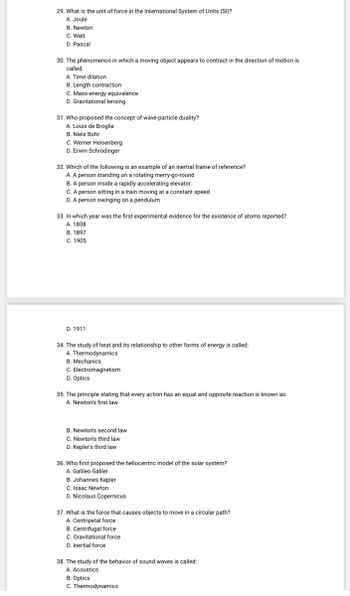Question
thumb_up100%
INSTRUCTION: Select the best answer for each question and provide the solution if required.

Transcribed Image Text:29. What is the unit of force in the International System of Units (SI)?
A. Joule
B. Newton
C. Watt
D. Pascal
30. The phenomenon in which a moving object appears to contract in the direction of motion is
called:
A. Time dilation
B. Length contraction
C. Mass-energy equivalence
D. Gravitational lensing
31. Who proposed the concept of wave-particle duality?
A. Louis de Broglie
B. Niels Bohr
C. Werner Heisenberg
D. Erwin Schrödinger
32. Which of the following is an example of an inertial frame of reference?
A. A person standing on a rotating merry-go-round
B. A person inside a rapidly accelerating elevator
C. A person sitting in a train moving at a constant speed
D. A person swinging on a pendulum
33. In which year was the first experimental evidence for the existence of atoms reported?
A. 1808
B. 1897
C. 1905
D. 1911
34. The study of heat and its relationship to other forms of energy is called:
A. Thermodynamics
B. Mechanics
C. Electromagnetism
D. Optics
35. The principle stating that every action has an equal and opposite reaction is known as:
A. Newton's first law
B. Newton's second law
C. Newton's third law
D. Kepler's third law
36. Who first proposed the heliocentric model of the solar system?
A. Galileo Galilei
B. Johannes Kepler
C. Isaac Newton
D. Nicolaus Copernicus
37. What is the force that causes objects to move in a circular path?
A. Centripetal force
B. Centrifugal force
C. Gravitational force
D. Inertial force
38. The study of the behavior of sound waves is called:
A. Acoustics
B. Optics
C. Thermodynamics

Transcribed Image Text:39. Who is credited with the development of the first successful atomic model?
A. J.J. Thomson
B. Niels Bohr
C. Ernest Rutherford
D. Max Planck
40. The phenomenon in which time appears to slow down for an object in motion is called:
A. Time dilation
B. Length contraction
C. Mass-energy equivalence
D. Gravitational lensing
41. The study of the Earth's physical properties, including its structure, composition, and
behavior, is called:
A. Geophysics
B. Meteorology
C. Oceanography
D. Astronomy
42. What is the principle stating that energy is quantized and is emitted or absorbed in discrete
packets called quanta?
A. Planck's radiation law
B. Planck's quantum hypothesis
C. Heisenberg's uncertainty principle
D. De Broglie's wave-particle duality
43. Who is credited with the discovery of X-rays?
A. Wilhelm Conrad Röntgen
B. Henri Becquerel
C. Marie Curie
D. Max von Laue
44. The study of the motion of celestial bodies under the influence of gravity is called:
A. Astrodynamics
B. Astrophysics
C. Celestial mechanics
D. Orbital mechanics
45. Who first discovered the relationship between electricity and magnetism?
A. Michael Faraday
B. André-Marie Ampère
C. Georg Simon Ohm
D. James Clerk Maxwell
46. What is the unit of work or energy in the International System of Units (SI)?
A. Joule
B. Newton
C. Watt
D. Pascal
Expert Solution
This question has been solved!
Explore an expertly crafted, step-by-step solution for a thorough understanding of key concepts.
Step 1: Answer for question number 29
VIEW Step 2: Answer for question no 30
VIEW Step 3: Answer for question no 31
VIEW Step 4: Answer for question number 32
VIEW Step 5: Answer for question number 33 , 34 and 35
VIEW Step 6: Answer for question number 36,37 and 38
VIEW Step 7: Answer for question number 39,40,41
VIEW Step 8: Answer for question number 42,43,44,45
VIEW Solution
VIEW Step by stepSolved in 9 steps

Knowledge Booster
Similar questions
- physics homework problem that doesn’t have an example type in the book. I do not earn points for the homework in my class, the problems are just practice for my quiz.arrow_forwardPlease answer question and just send me the paper solutions asap dont type the answer ex3 and use this equation asap please fasterarrow_forwardCan you please answer number 5 and show all of the steps to they solutionarrow_forward
- where a 0, to find the a and B, such that y = ax + B. Your answers should be expressed in terms of a and b. α Eliminate the parameter t from the set of parametric equations. x = at + b y = 2t - 1 Вarrow_forwardHelp with the following question, select the correct answer choicearrow_forwardPlease answer with the step solution. Im needed in 30 minutes thank uarrow_forward
arrow_back_ios
arrow_forward_ios